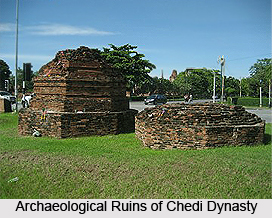 Chedi formed one of the most ancient tribes among the Ksatriyas in early Vedic times. As early as the period of the Rig Veda, the Chedi kings had acquired great renown by their munificent gifts at sacrifices, and also by their great prowess in battle. The Chedi are not expressly mentioned in the later Vedic literature, but that did not mean that they had become extinct, for they appear in the Mahabharata as one of the leading powers of Northern India. It is probable that they were not so prominent in their sacrificial rites, or their political power, in the Brahman age as they had been in the earlier era of the Rig Vedic hymns.
Chedi formed one of the most ancient tribes among the Ksatriyas in early Vedic times. As early as the period of the Rig Veda, the Chedi kings had acquired great renown by their munificent gifts at sacrifices, and also by their great prowess in battle. The Chedi are not expressly mentioned in the later Vedic literature, but that did not mean that they had become extinct, for they appear in the Mahabharata as one of the leading powers of Northern India. It is probable that they were not so prominent in their sacrificial rites, or their political power, in the Brahman age as they had been in the earlier era of the Rig Vedic hymns.
Mahabharata has glorified a Chedi king called Vasu. Vasu acquired the designation of Uparicara. This Chedi king was a Paurava and was characterised by great religious merit. In the Adi Parva of the Mahabharata, it has been mentioned that Vasu, the Paurava, conquered the beautiful and excellent kingdom of the Chedi on the advice of the god Indra.
History says that the next Chedi monarch who appears to have acquired considerable power in the epic period is Shishupala who is called Damaghosasuta or Damaghosatmaja. He had allied himself with the great Jarasandha and on account of his heroism was appointed general of the Magadhan emperor. It has been recorded that Sishupala`s conduct had roused the displeasure of many of the Kshatriya tribes of his time, but he was looked upon with such fear that he was considered as an incarnation of the great Daitya Hiranya-Kasipu, and the epic refers to the fact he bore a charmed life unassailable by any ordinary mortal.
Several accounts say that the Chedi had helped the Pandavas in the great battle of Kurukshetra. It has been stated that during those times that is during the time of the Mahabharata the Chedi had been very powerful.
Mahabharata narrates that Chedi allied in a group with western tribes like the as the Panchala, Matsyas and Karusas, and also with peoples who lived in the east, such as the Kasis and Kosalas. The closest neighbours of the Chedi were the Matsyas.
Chedi has been mentioned in many of the Puranic treatise like the Padma Purana. They have mentioned Chedi as a janapada or a country. Chedi is also mentioned in the Jaina and Buddhist literatures as one of the sixteen mahajanapadas. Some historical account says that Chedi comprised the southern portion of Bundelkhand and northern portion of Jabalpur.
About the Chedi people it has been said in the Adi Parva of the Mahabharata, that the kingdom of Chedi was full of riches, gems and precious stones, and contained much mineral wealth. The cities in the kingdom were full of honest, virtuous, and contented people. The sons were mindful of their parents` welfare. In Chedi, the four castes were engaged in doing their respective duties. The hospitality of the Chedi people is well known.
The Chedi of the Vedic period, like other tribes, e.g. the Purus, were a group of families. The whole tribe was governed by a Raja whose power was checked to an undefined extent by a tribal council.
Coins issued by the Chedi kings have been discovered. Gold, silver and copper coins of Gangeyadeva have been discovered. On one side is the name of the king in two lines, and on the other a figure of a four-armed goddess. Coins of one king of the Chedi or Kalacuri dynasty of Kalyanapura have also been discovered. On one side of the coins is engraved the figure of the boar-incarnation, and on the other is written ` Murari` in Nagari characters. Murari was perhaps another name of Somesvaradeva, the second king of the Kalachuri Chedi dynasty.





















